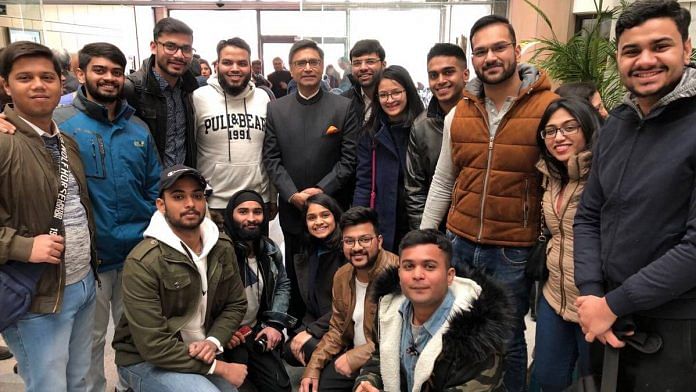New Delhi: There are nearly 700 Indian students studying in Chinese city Wuhan — the epicentre of the coronavirus outbreak.
The Indian government has so far evacuated over 600 Indians from Wuhan, including students.
There is a huge population of Indian students in China and almost every Chinese city has Indian students.
According to the official data of the Ministry of Human Resource Development (MHRD), 23,000 Indian students are studying in China and of this, 21,000 are pursuing medicine — as of 2019. The remaining students are pursuing engineering and language studies.
Also read: Coronavirus in China claims 254 lives — highest in a single day, death toll rises to 1,367
What makes China an attractive option
India’s obsession with China, primarily to obtain a medical degree, began around 10-12 years ago — mostly among parents in south India.
Limited number of medical seats in Indian government colleges and expensive private institutes made Indian students look at options outside the country — in nations like China, Russia, Kyrgyztan and Bangladesh.
Admission to colleges outside India is also done on the basis of NEET (National Eligibility cum Entrance Test) scores.
However, while India’s government colleges require a score of nearly 600 out of 720 marks, Chinese colleges give admission even if a student scores 400 or less.
“Students who cannot afford an expensive medical degree in a private medical college in India choose China as an option because one can pursue medicine starting with Rs 3 lakh per annum in China. For Indian private colleges, the fee would be much high. Apart from this, it’s easier to get admission outside India, the NEET score required is less,” said Neeraj Chaurasiya, a consultant with MBBS Gurukul, a consultant agency.
“Apart from this, students also feel there is a similarity in terms of food in China and they are able to adjust to the culture better than Russia or anywhere else… plus its closer to India,” he added.
The Medical Council of India (MCI) for the academic year 2019-20 had recognised 45 universities and colleges in China where Indian students can pursue medical courses. All the institutes approved by the MCI offer degrees in English.
All the MCI-recognised universities are funded by the Chinese government and the annual tuition fee is around Rs 3 lakh.
Government colleges in India also charge between Rs 50,000 and Rs 2 lakh annually, but the number of seats is very limited — nearly 31,000 seats are on offer each year.
Private colleges, meanwhile, charge whopping amounts from students — extending up to even Rs 10 lakh per annum.
MCI-recognised Chinese institutes offer a total of 3,370 seats to international students and maximum seats are taken up by Indian students.
Indian students also take admission to non-MCI recognised colleges, which offer bilingual degrees.
China’s English MBBS curriculum same as India’s
Professor Srikanth Kondapalli, a faculty member at the Centre for East Asian Studies in JNU’s School of International Studies, explained, “Around 10-12 years ago, those who could not study medicine in India would go to Russia, but then it started becoming unsafe for the students there because of racism and then China started emerging as a preferred destination.”
“Almost 90 per cent of the Indians going to China go for MBBS, rest of them do engineering and then there are some others who go for management and language courses but a large chunk is only for medicine,” he said.
“The reasons are very simple… the English MBBS curriculum in China is very similar to that of the Indian MBBS curriculum. Plus, it is affordable for Indian parents. Some of the institutions there offer medical education at a price even lesser than that of Indian private universities,” Kondapalli added.
Professor Jabin Jacob, who teaches at the Department of International Relations and Governance Studies at Shiv Nadar University, said the infrastructure, labs and equipment in Chinese universities are much better than their Indian counterparts.
“This is also a reason that more students find China an attractive destination,” he said.
“Over the time, it has become more organised also. The embassy keeps a check on the universities and warns students against going to any fake institution. Many students also use China as a stepping stone to the US,” Jacob added.
Abundance of scholarships
Professor Jacob said a small number of Indian students go to China to study languages.
“Almost 90-95 per cent of Indian students go to China for MBBS and the remaining go for languages. India has been sending students for language studies to China for a very long time. There are a number of scholarships as well between the two countries. This also increases the number of students.”
Apart from individual universities, scholarships are provided by the government of every province in China.
These scholarships are mostly given to students to study Mandarin. Students often opt for a one-year language study programme or bachelors or masters programme.
Also read: ‘It’s like house arrest’ — Indians in coronavirus-hit Wuhan desperate to return home



